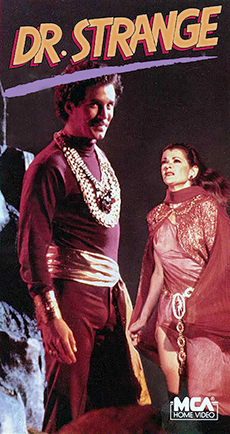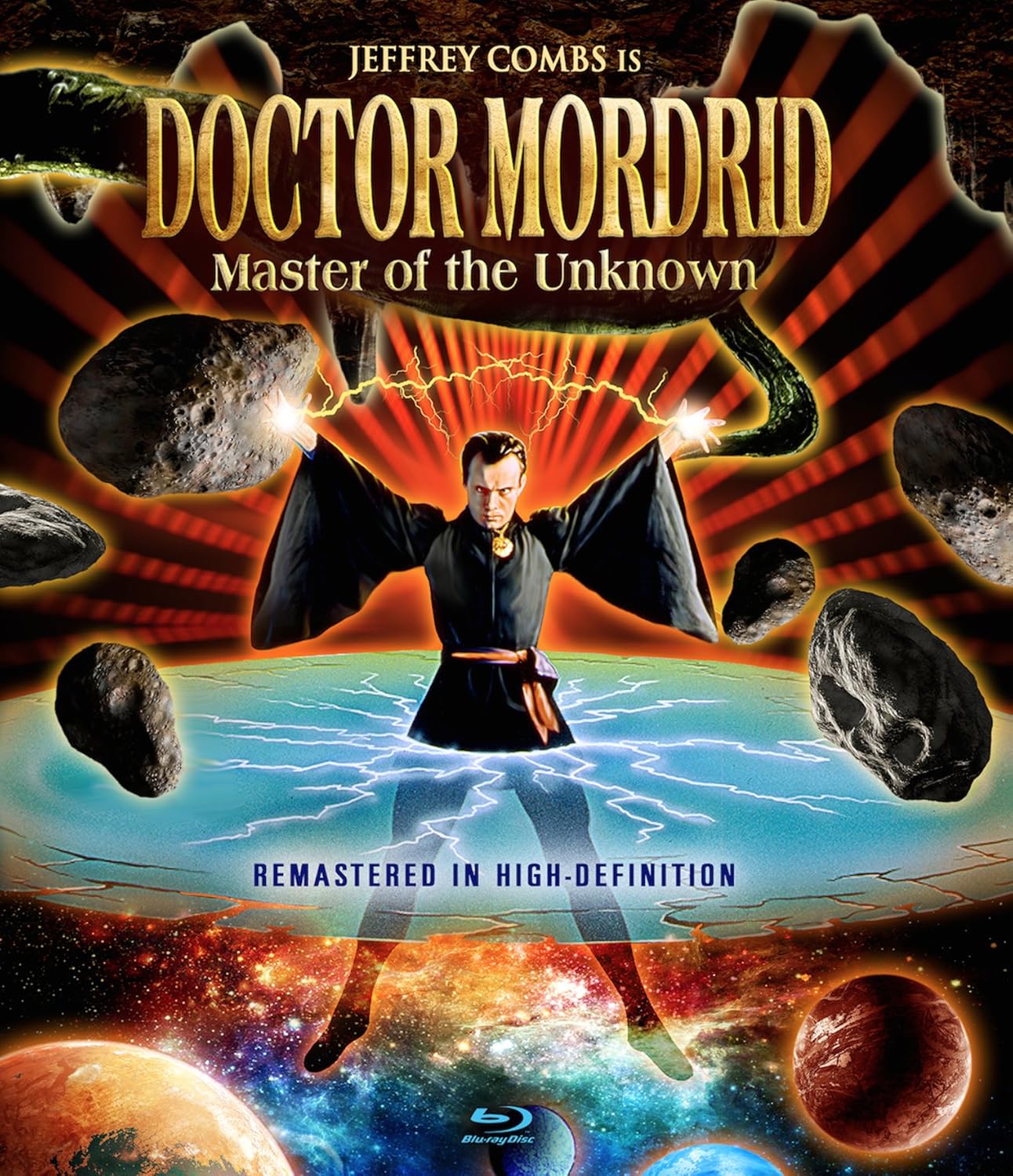 |
| VHS Cover |
Starring Peter Hooten as Dr. Stephen Strange; with Jessica Walter and John Mills
If you’ve got a fever for fantasy TV even the Winds of Watoomb won’t quell, then this might be just the prescription.
Doctor Strange, The Master of the Mystic Arts and Sorcerer Supreme created for Marvel Comics by writer Stan Lee and artist Steve Ditko, first appeared in Strange Tales No. 110, dated July 1963, a year before I was born.
He came to television in a much watered-down version, via a pilot film that even abbreviated Strange’s title as Dr. Strange, in the autumn after I turned 14. I was already a fan of the source material and at the perfect age for a good horror-tinged magical adventure. I watched the show on my Dad’s TV in the living room area of a mobile home he was renting in Gonzales, Florida, if I'm recalling correctly.
It was miles ahead of other Comics-to-TV efforts of the era, from a Hulk with green body paint, to a Spider-Man who couldn’t realistically fight bank robbers (much less a super villain), to a Captain America who traded his winged mask for a motorcycle helmet. At least with Strange you got to see magic lightning bolts and weird dimensions.
 |
| Disco Strange |
The movie diverged from the original material, although Lee apparently felt it was one of the better of Marvel’s 1970s TV adaptations. In an interview published in Comics Feature magazine (January 1985), Lee recalled being “pleased with Dr. Strange and The (Incredible) Hulk.” He added that Strange might have had higher ratings if it hadn’t been broadcast opposite Roots.
In the comics, Stephen Strange is a gifted but arrogant surgeon who loses his dexterity after a car crash and becomes a drunk because he can’t make tons of cash as a surgeon any more. Hearing talk of an “Ancient One” in Tibet who can heal anyone, he travels there on a quest to restore his hands so he can regain his medical practice.
Instead, he is initiated into the hidden world of magicians and eventually becomes the “Sorcerer Supreme” of Earth. He takes on a servant, Wong, and lives in a weird brownstone in Greenwich Village, NYC. And he soon gets a hot silver-haired girlfriend from another dimension, Clea, who becomes his pupil as well as his lover.
Strange has adventures in other dimensions, superbly psychedelic and appropriate for the 1960s, as originally conceived by Ditko. He fights entities like Mephisto, Nightmare and Dormammu, as well as his mortal enemy, Baron Mordo. He hangs out in his Sanctum Sanctorum and gets into scraps alongside the Defenders (initially, Silver Surfer, Hulk and Namor the Submariner).
These battles and other-dimensional jaunts were beyond the scope of 1978-era special effects (at least, on a TV movie budget), but the pilot film makes a valiant effort. Before it’s over, Strange visits a nether-dimension, we catch glimpses of the demon Balzaroth (voiced by Ted “Lurch” Cassidy, uncredited), and our cast exchange magic lightning blasts.
It’s the changes to the mythos for its TV incarnation that don’t ring true to this True Believer, and one wonders if they were made for fear of how audiences would respond to an Asian master in post-Vietnam USA, or a devilish Mephisto (this was a time when Bible-thumping caused all sorts of censorship in fantasy TV; Google some of the censors’ reactions to Star Trek reruns some time just to boggle your mind).
 |
| Wong and Lindmer |
The usually mesmerizing Jessica Walter (lately seen on Arrested Development and heard on Archer) plays Morgan Le Fay, Merlin’s old enemy (who was, as you may recall from repeated viewings of Excalibur, the half-sister of King Arthur and the mother of his bastard son, Mordred). While she is physically voluptuous and tempting in her low-cut tops, her delivery of dialogue is flat, and she’s played a bit too cold for you to ever believe Strange could be swayed to her side of the battle.
Clea is presented as a college student haunted by Morgan; she’s played by Eddie Benton (who later acted under the name Anne-Marie Martin in episodes of Buck Rogers and other 1980s shows, but is perhaps best known as co-writer of the 1996 film Twister with her then-husband, the late author Michael Crichton). Clea falls under Morgan’s spell, and Strange seeks alternative therapies for her.
 |
| Strange and Morgana |
The film opens with an image to excite any Strange fan’s heart: We’re in a weird realm of rocky islands floating in space. A stop-motion demon gives Morgan the chance to redeem her earlier failures by defeating Lindmer and turning his chosen apprentice to the Dark Side, or some such. So far, so good.
But the interest dissipates pretty fast. The film becomes overly talky, and little action of any consequence takes place for the next hour, putting the majority of effects and action in the final segment of the show. Strange doesn’t even dress — well, strange — until the last act, first in a very cool cloak and chains bestowed on him by Morgan, and later in a lame disco blouse with a starburst and yellow cape. Both costumes hearken to the various comic versions of Strange’s attire, but neither one captures the spirit.
 |
| Strange by any Other Name |
Over the years, the comic Strange has been rebooted, retooled and refocused. He’s been de-aged, split into multiple persons with different names, and even gave up his face for a while, replacing it with a blue “mask.”
Likewise, in some writers’ hands, he’s selfless and heroic, while others paint him as distant and possibly deviant, acting to protect his own power base as much as the innocent souls in this reality. His recent appearance in Matt Fraction’s short-lived Defenders title made him a little scary.
I always was happier seeing Strange as a mixture of the two extremes, much as he was initially portrayed: A self-righteous man who was knocked down, broken, and in the process of rebuilding himself spiritually as he learns to serve others — a hero overcoming deep faults against massive odds.
That’s kind of what this pilot film embodies: It’s obviously broken, but it contains enough magic to make you believe that, if it had gone to series, it could have developed into something deeper — until you realize it was the 1970s and even the Hoary Hosts of Hoggoth couldn’t have energized it enough.
We’re probably better off watching Kolchak reruns, dreaming of what might have been, and looking forward to a Marvel motion picture starring Benedict Cumberbatch and Tilda Swinton. But until then, here's the whole movie from YouTube:
No comments:
Post a Comment